A call came into the Thought Industries office on the heels of our Cognition conference in 2020. On the other end of the line was a representative of John Wiley & Sons, a global publisher specializing in research and career-connected education. The reason for the call? Wiley asked if we would be interested in developing a book-length treatment of the methodology for developing customer education programs we rolled out at Cognition 2020. Indeed, we would.
A Catalyst … and a Confirmation
That call proved to be both a catalyst and a confirmation. As a catalyst, it was the spark needed to get us to muster the resources and commit the time and effort required to produce The Customer Education Playbook: How Leading Companies Use Training to Engage, Convert and Retain Customers. The book is available from Wiley on April 19.
As important, though, the interest from Wiley served as further validation that customer education is a strategic business function that has measurable influence on critically important business outcomes. Wiley saw the market interest evident at Cognition and the response to the methodology we introduced there and concluded the time was right for this book.

Changing Dynamics for Customer Education Supply and Demand
Changes in demand for customer education programs and in the way those demands are being fulfilled have helped elevate customer education as a strategic business function. On the demand side, consider the emergence of complex products and services offered on a subscription business. These offerings can be difficult for customers to learn and master. Furthermore, it takes only a few bad experiences to motivate customers to consider alternatives. Hence, there is a true and measurable premium on creating faster paths to realizing the promised value and benefits of such products and services. Meanwhile, customers’ expectations regarding the education and training that should be available to them are rising in every dimension, from how thorough and engaging the content should be to how appropriately and conveniently it is delivered and whether or not it truly helps them become more productive and proficient in doing their jobs.
On the supply side, advances in technology are transforming how customer education is delivered. While there will always be a place for on-premise training, more and more customers want to learn in the context of the regular flow of their work and how they do their jobs. That, in turn, is driving an increased supply of “moment of need” training and education and a broad expansion in modes of delivering that content, from searchable FAQs to pop-up coaching to podcasts to need-specific video tutorials to virtual instructor-led training and more.
The Readers We Had in Mind
For the customer education programs we help our clients develop and implement, a critical part of our process is making sure we understand the jobs the people these programs aim to train and educate are trying to do. We needed to make a similar assessment as we developed this book. We needed to decide who we envisioned its readers to be and what those readers would want to know and learn.
We wrote the book with two audiences in mind. One is business leaders, customer success leaders and executives who are thinking about strategies they can implement to drive renewals, increase net recurring revenue, grow brand awareness and earn enduring customer loyalty. The first part of the book is aimed at them. This is a readership concerned about the business outcomes customer education can influence. With research done for the book, we show them that customer education can be a significant competitive differentiator and a powerful way to attract and retain customers.
Our second audience is customer education practitioners. The second part of the book is for those responsible for actually creating and implementing customer education strategy. We wanted the book to serve as a how-to manual for practitioners. That is why we filled it with practical recommendations and actionable insights from real experiences, including profiles of a dozen customer education leaders.
The book’s recommendations and insights are based on hundreds of survey responses and practitioner interviews. We are confident we captured a broad range of best practices, based on real world experience, for critical tasks including gaining executive buy-in, developing engaging and relevant content, and measuring program success. We think this amalgamation of practical, actionable information regarding how to develop, implement and measure customer education programs fills a gap that has existed to date in the customer education conversation.
What Should Readers Take Away?
Like any authors, we hope readers will want to read this book cover to cover to learn about the role of customer education in driving desired business outcomes and how to build successful customer education programs within their own organizations. But we also hope readers don’t just shelve the book after reading it. “Mission accomplished” for us would mean readers are keeping the book at hand to turn to as a reference, thought starter or source of inspiration when they are creating new customer education programs, striving to make educational content more engaging or determining how best to measure program effectiveness. Moreover, we expect readers will take away from the book a deeper appreciation of customer education as a business discipline that, executed properly, delivers lasting value. That value manifests in the form of customers who, having mastered new skills that make them more successful in their work, become loyal advocates for the brands that helped make that happen.
You can get your copy of ‘The Customer Education Playbook’ for yourself and your team here.


